2000 FORD CROWN VICTORIA wiper blades
[x] Cancel search: wiper bladesPage 161 of 224
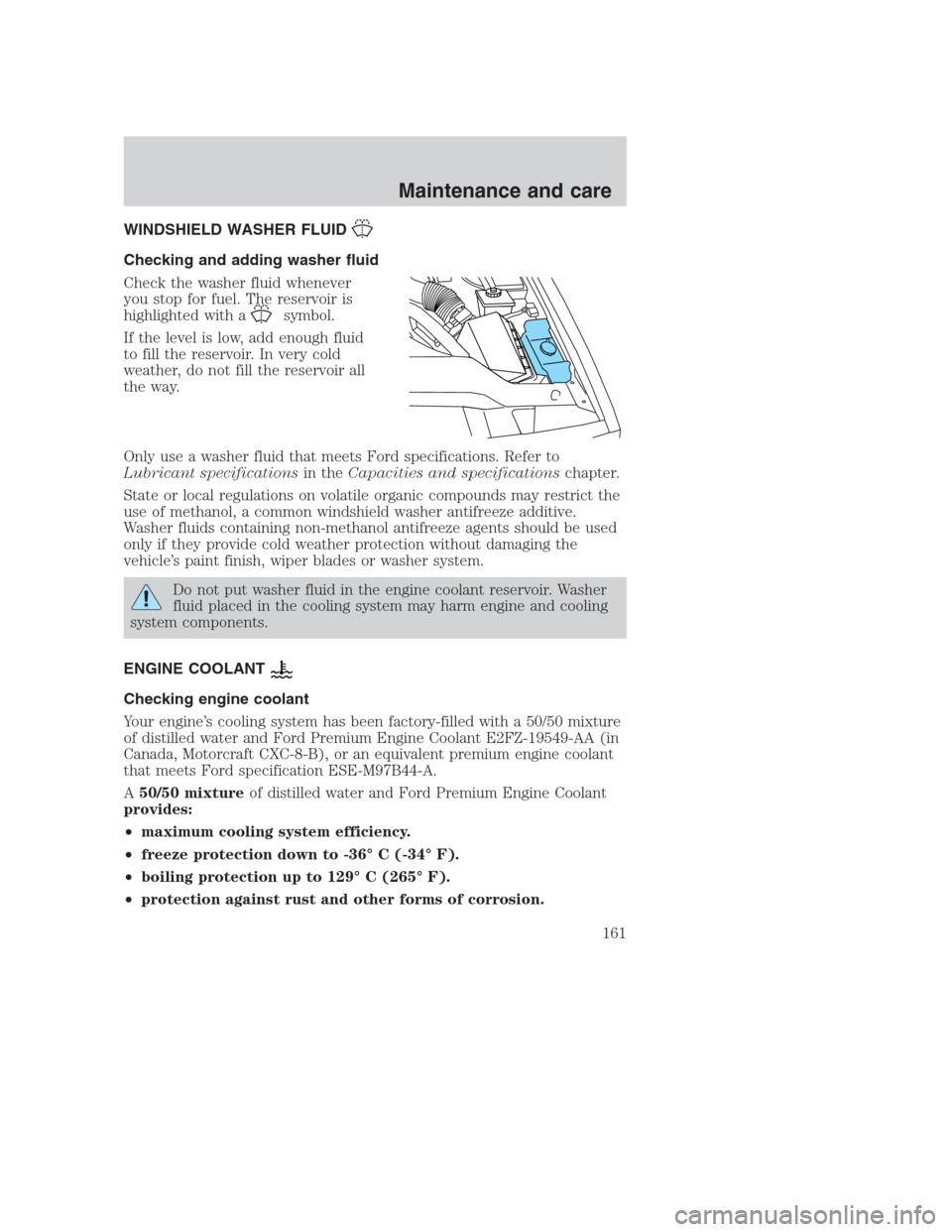
WINDSHIELD WASHER FLUID
Checking and adding washer fluid
Check the washer fluid whenever
you stop for fuel. The reservoir is
highlighted with a
symbol.
If the level is low, add enough fluid
to fill the reservoir. In very cold
weather, do not fill the reservoir all
the way.
Only use a washer fluid that meets Ford specifications. Refer to
Lubricant specificationsin theCapacities and specificationschapter.
State or local regulations on volatile organic compounds may restrict the
use of methanol, a common windshield washer antifreeze additive.
Washer fluids containing non-methanol antifreeze agents should be used
only if they provide cold weather protection without damaging the
vehicle’s paint finish, wiper blades or washer system.
Do not put washer fluid in the engine coolant reservoir. Washer
fluid placed in the cooling system may harm engine and cooling
system components.
ENGINE COOLANT
Checking engine coolant
Your engine’s cooling system has been factory-filled with a 50/50 mixture
of distilled water and Ford Premium Engine Coolant E2FZ-19549-AA (in
Canada, Motorcraft CXC-8-B), or an equivalent premium engine coolant
that meets Ford specification ESE-M97B44-A.
A50/50 mixtureof distilled water and Ford Premium Engine Coolant
provides:
•maximum cooling system efficiency.
•freeze protection down to -36° C (-34° F).
•boiling protection up to 129° C (265° F).
•protection against rust and other forms of corrosion.
Maintenance and care
161
Page 174 of 224
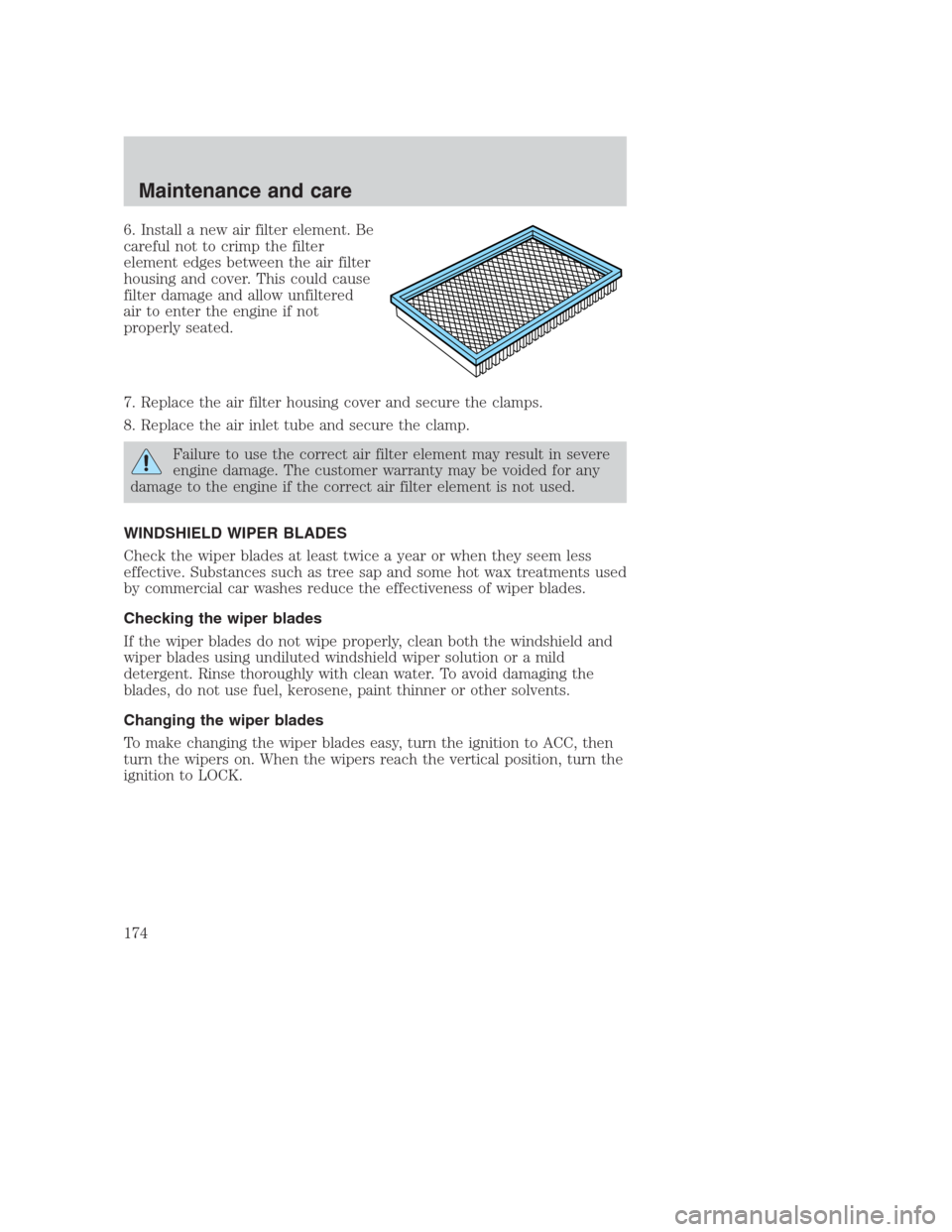
6. Install a new air filter element. Be
careful not to crimp the filter
element edges between the air filter
housing and cover. This could cause
filter damage and allow unfiltered
air to enter the engine if not
properly seated.
7. Replace the air filter housing cover and secure the clamps.
8. Replace the air inlet tube and secure the clamp.
Failure to use the correct air filter element may result in severe
engine damage. The customer warranty may be voided for any
damage to the engine if the correct air filter element is not used.
WINDSHIELD WIPER BLADES
Check the wiper blades at least twice a year or when they seem less
effective. Substances such as tree sap and some hot wax treatments used
by commercial car washes reduce the effectiveness of wiper blades.
Checking the wiper blades
If the wiper blades do not wipe properly, clean both the windshield and
wiper blades using undiluted windshield wiper solution or a mild
detergent. Rinse thoroughly with clean water. To avoid damaging the
blades, do not use fuel, kerosene, paint thinner or other solvents.
Changing the wiper blades
To make changing the wiper blades easy, turn the ignition to ACC, then
turn the wipers on. When the wipers reach the vertical position, turn the
ignition to LOCK.
Maintenance and care
174
Page 175 of 224
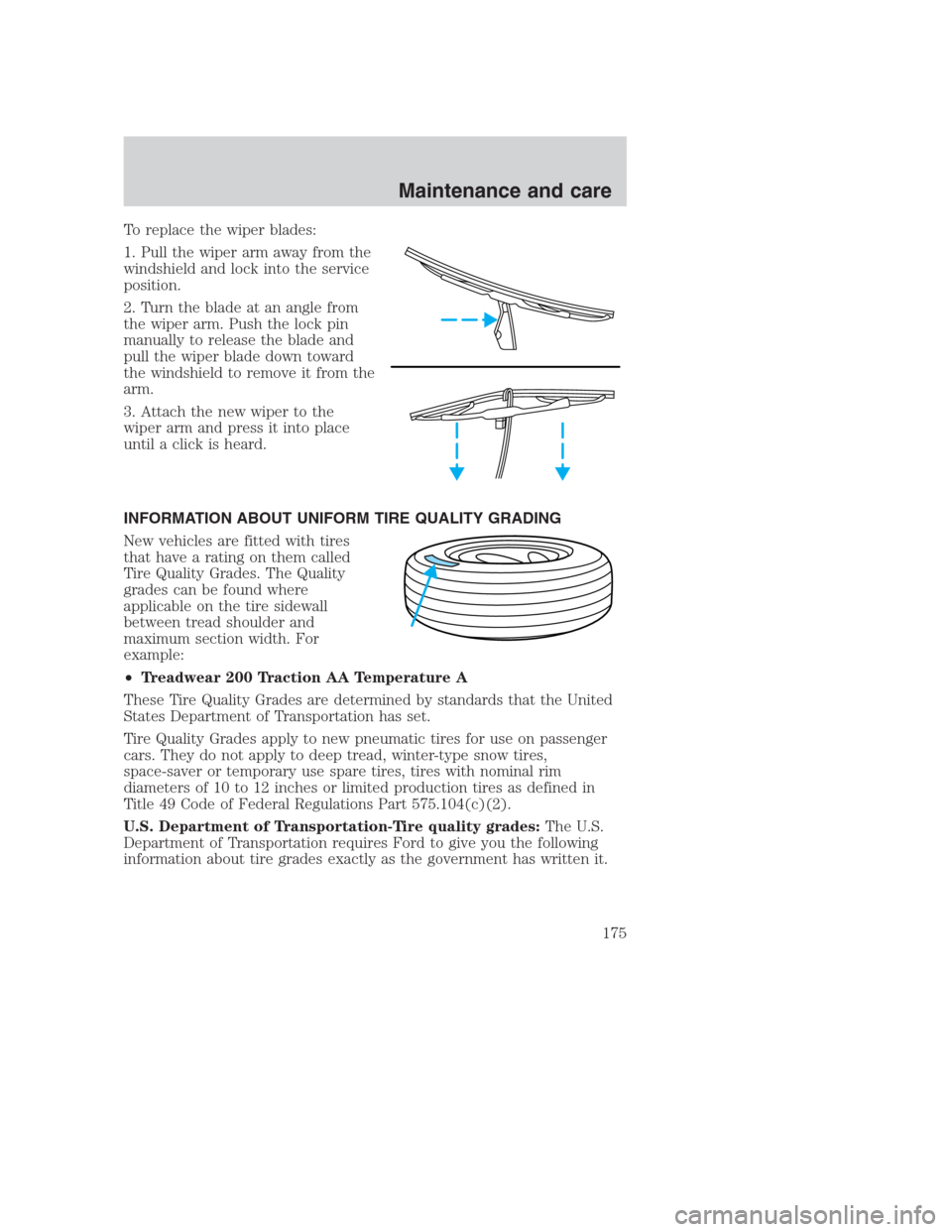
To replace the wiper blades:
1. Pull the wiper arm away from the
windshield and lock into the service
position.
2. Turn the blade at an angle from
the wiper arm. Push the lock pin
manually to release the blade and
pull the wiper blade down toward
the windshield to remove it from the
arm.
3. Attach the new wiper to the
wiper arm and press it into place
until a click is heard.
INFORMATION ABOUT UNIFORM TIRE QUALITY GRADING
New vehicles are fitted with tires
that have a rating on them called
Tire Quality Grades. The Quality
grades can be found where
applicable on the tire sidewall
between tread shoulder and
maximum section width. For
example:
•Treadwear 200 Traction AA Temperature A
These Tire Quality Grades are determined by standards that the United
States Department of Transportation has set.
Tire Quality Grades apply to new pneumatic tires for use on passenger
cars. They do not apply to deep tread, winter-type snow tires,
space-saver or temporary use spare tires, tires with nominal rim
diameters of 10 to 12 inches or limited production tires as defined in
Title 49 Code of Federal Regulations Part 575.104(c)(2).
U.S. Department of Transportation-Tire quality grades:The U.S.
Department of Transportation requires Ford to give you the following
information about tire grades exactly as the government has written it.
Maintenance and care
175
Page 195 of 224

Washing your vehicle
Wash your vehicle regularly with
cold or lukewarm water. Never use
strong detergents or soap. If your
vehicle is particularly dirty, use a
quality car wash detergent. Always
use a clean sponge, washing glove
or similar device and plenty of water
for best results. To avoid spots,
avoid washing when the hood is still
warm, immediately after or during
exposure to strong sunlight.
During winter months, it is especially important to wash the vehicle on a
regular basis. Large quantities of dirt and road salt are difficult to
remove and also cause damage to the vehicle.
Any gasoline spilled on the vehicle or deposits such as bird droppings
should be washed and sponged off as soon as possible. Deposits not
removed promptly can cause damage to the vehicle’s paintwork.
Remove any exterior accessories, such as antennas, before entering a car
wash. If you have wax applied to the vehicle at a commercial car wash, it
is recommended that you clean the wiper blades and windshield as
described inCleaning the wiper blades and windshield.
After washing, apply the brakes several times to dry them.
Waxing your vehicle
Waxing your vehicle on a regular basis will reduce minor scratches and
paint damage.
Wax when water stops beading on the surface. This could be every three
or four months, depending on operating conditions.
Use only carnauba or synthetic-based waxes. Use a cleaning fluid with a
clean cloth to remove any bugs before waxing your vehicle. Use tar
remover to remove any tar spots.
Avoid getting wax on the windshield, or on any surfaces which appear
coarse or bumpy. If you have wax applied at a commercial car wash, it is
recommended that you clean the wiper blades and windshield as
described inCleaning the wiper blades and windshield.
Maintenance and care
195
Page 197 of 224
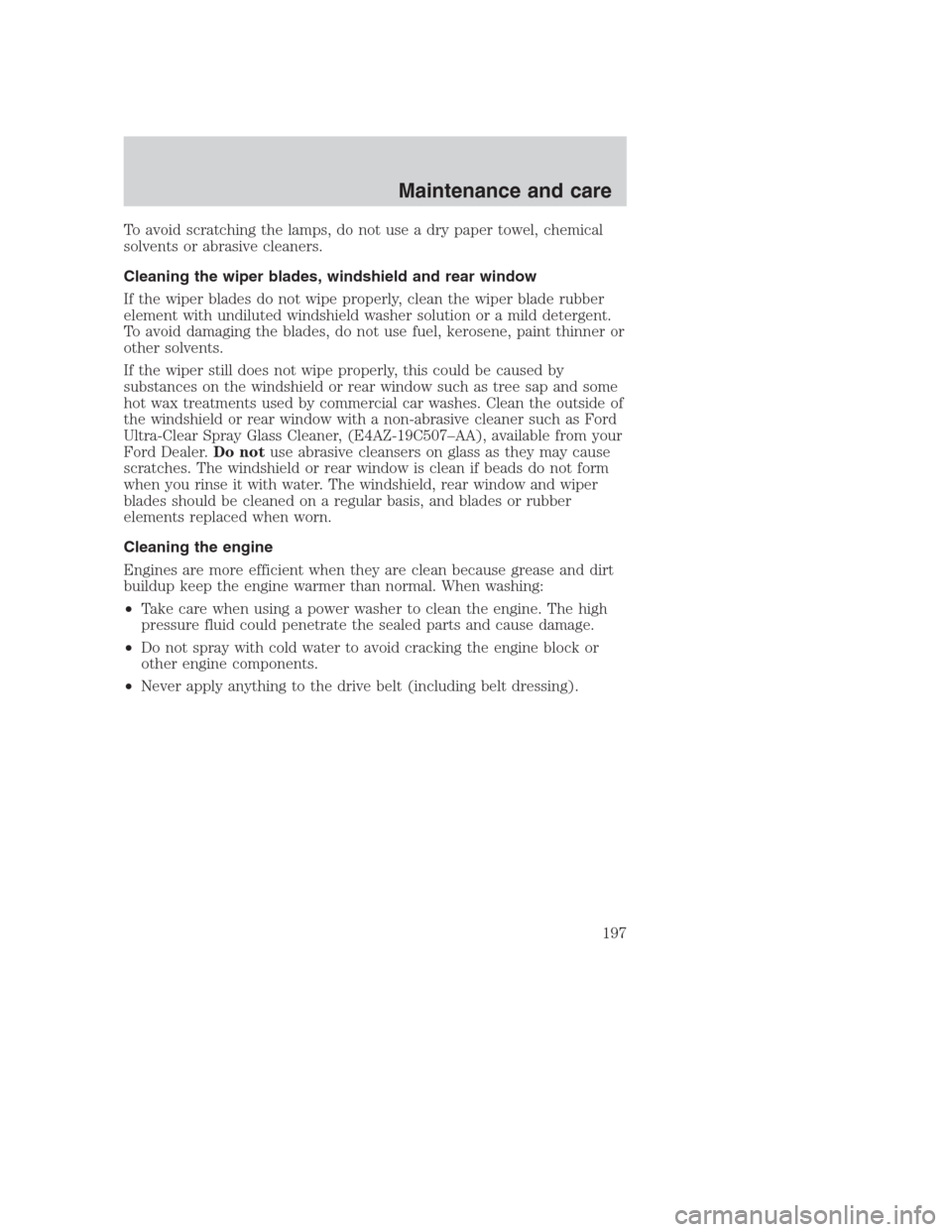
To avoid scratching the lamps, do not use a dry paper towel, chemical
solvents or abrasive cleaners.
Cleaning the wiper blades, windshield and rear window
If the wiper blades do not wipe properly, clean the wiper blade rubber
element with undiluted windshield washer solution or a mild detergent.
To avoid damaging the blades, do not use fuel, kerosene, paint thinner or
other solvents.
If the wiper still does not wipe properly, this could be caused by
substances on the windshield or rear window such as tree sap and some
hot wax treatments used by commercial car washes. Clean the outside of
the windshield or rear window with a non-abrasive cleaner such as Ford
Ultra-Clear Spray Glass Cleaner, (E4AZ-19C507–AA), available from your
Ford Dealer.Do notuse abrasive cleansers on glass as they may cause
scratches. The windshield or rear window is clean if beads do not form
when you rinse it with water. The windshield, rear window and wiper
blades should be cleaned on a regular basis, and blades or rubber
elements replaced when worn.
Cleaning the engine
Engines are more efficient when they are clean because grease and dirt
buildup keep the engine warmer than normal. When washing:
•Take care when using a power washer to clean the engine. The high
pressure fluid could penetrate the sealed parts and cause damage.
•Do not spray with cold water to avoid cracking the engine block or
other engine components.
•Never apply anything to the drive belt (including belt dressing).
Maintenance and care
197
Page 219 of 224
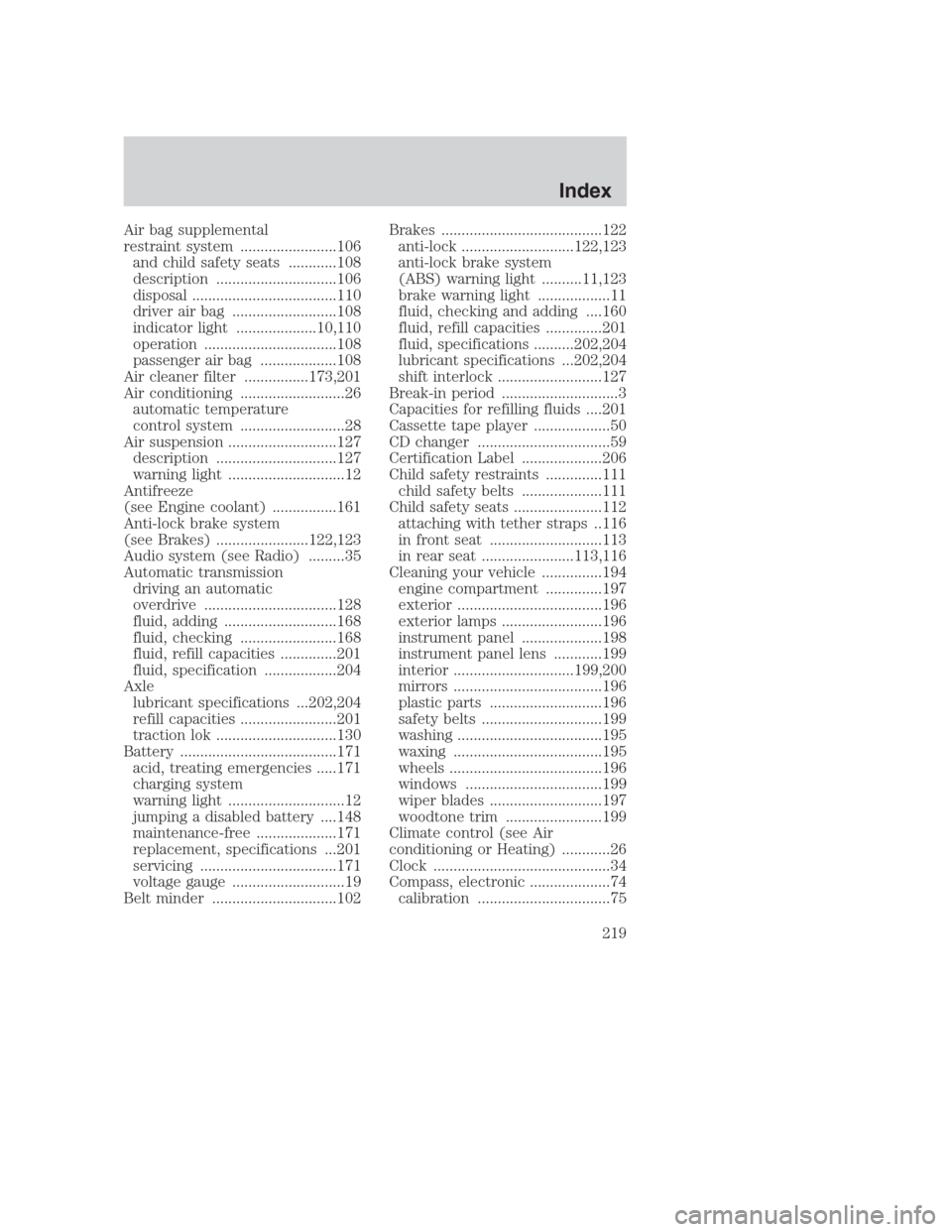
Air bag supplemental
restraint system ........................106
and child safety seats ............108
description ..............................106
disposal ....................................110
driver air bag ..........................108
indicator light ....................10,110
operation .................................108
passenger air bag ...................108
Air cleaner filter ................173,201
Air conditioning ..........................26
automatic temperature
control system ..........................28
Air suspension ...........................127
description ..............................127
warning light .............................12
Antifreeze
(see Engine coolant) ................161
Anti-lock brake system
(see Brakes) .......................122,123
Audio system (see Radio) .........35
Automatic transmission
driving an automatic
overdrive .................................128
fluid, adding ............................168
fluid, checking ........................168
fluid, refill capacities ..............201
fluid, specification ..................204
Axle
lubricant specifications ...202,204
refill capacities ........................201
traction lok ..............................130
Battery .......................................171
acid, treating emergencies .....171
charging system
warning light .............................12
jumping a disabled battery ....148
maintenance-free ....................171
replacement, specifications ...201
servicing ..................................171
voltage gauge ............................19
Belt minder ...............................102Brakes ........................................122
anti-lock ............................122,123
anti-lock brake system
(ABS) warning light ..........11,123
brake warning light ..................11
fluid, checking and adding ....160
fluid, refill capacities ..............201
fluid, specifications ..........202,204
lubricant specifications ...202,204
shift interlock ..........................127
Break-in period .............................3
Capacities for refilling fluids ....201
Cassette tape player ...................50
CD changer .................................59
Certification Label ....................206
Child safety restraints ..............111
child safety belts ....................111
Child safety seats ......................112
attaching with tether straps ..116
in front seat ............................113
in rear seat .......................113,116
Cleaning your vehicle ...............194
engine compartment ..............197
exterior ....................................196
exterior lamps .........................196
instrument panel ....................198
instrument panel lens ............199
interior ..............................199,200
mirrors .....................................196
plastic parts ............................196
safety belts ..............................199
washing ....................................195
waxing .....................................195
wheels ......................................196
windows ..................................199
wiper blades ............................197
woodtone trim ........................199
Climate control (see Air
conditioning or Heating) ............26
Clock ............................................34
Compass, electronic ....................74
calibration .................................75
Index
219
Page 223 of 224
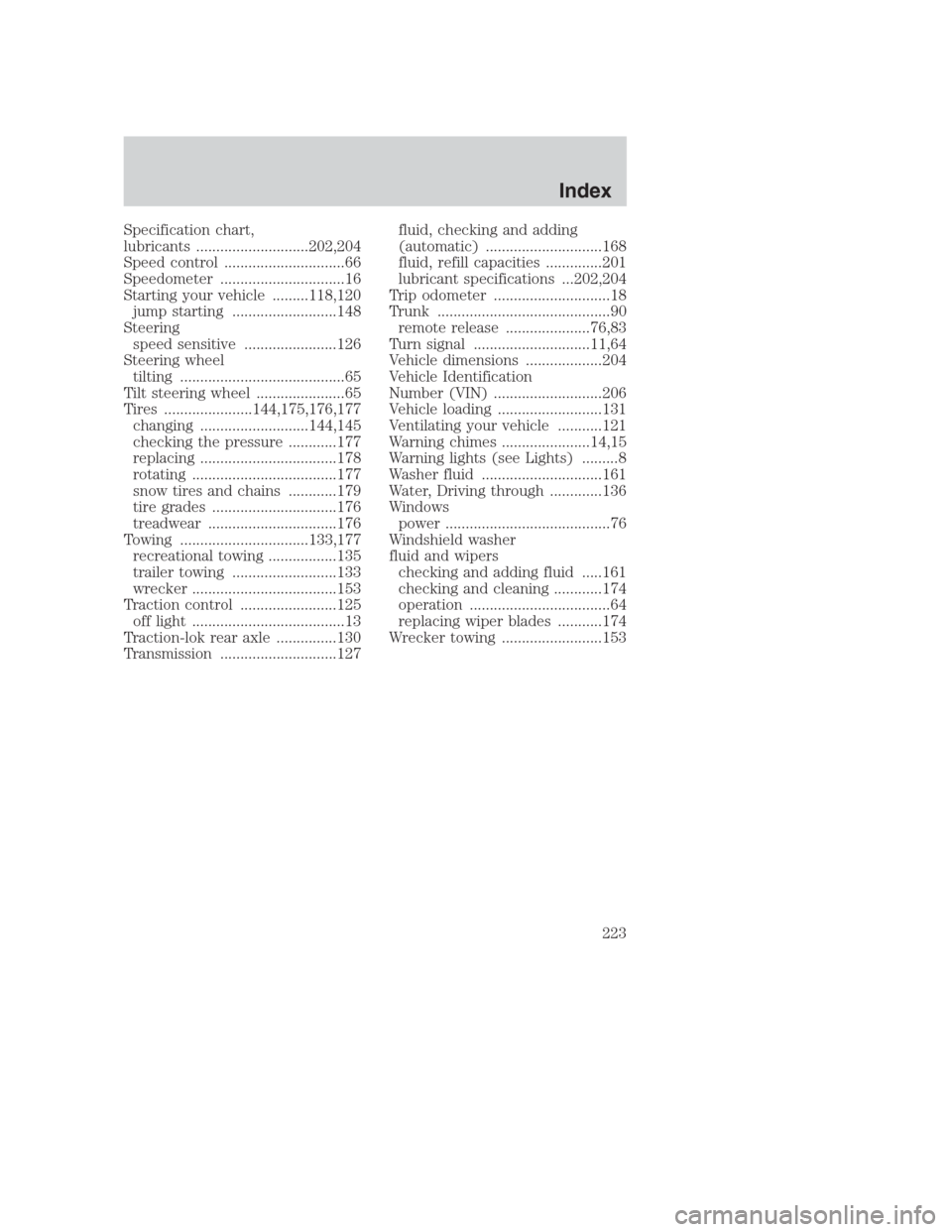
Specification chart,
lubricants ............................202,204
Speed control ..............................66
Speedometer ...............................16
Starting your vehicle .........118,120
jump starting ..........................148
Steering
speed sensitive .......................126
Steering wheel
tilting .........................................65
Tilt steering wheel ......................65
Tires ......................144,175,176,177
changing ...........................144,145
checking the pressure ............177
replacing ..................................178
rotating ....................................177
snow tires and chains ............179
tire grades ...............................176
treadwear ................................176
Towing ................................133,177
recreational towing .................135
trailer towing ..........................133
wrecker ....................................153
Traction control ........................125
off light ......................................13
Traction-lok rear axle ...............130
Transmission .............................127fluid, checking and adding
(automatic) .............................168
fluid, refill capacities ..............201
lubricant specifications ...202,204
Trip odometer .............................18
Trunk ...........................................90
remote release .....................76,83
Turn signal .............................11,64
Vehicle dimensions ...................204
Vehicle Identification
Number (VIN) ...........................206
Vehicle loading ..........................131
Ventilating your vehicle ...........121
Warning chimes ......................14,15
Warning lights (see Lights) .........8
Washer fluid ..............................161
Water, Driving through .............136
Windows
power .........................................76
Windshield washer
fluid and wipers
checking and adding fluid .....161
checking and cleaning ............174
operation ...................................64
replacing wiper blades ...........174
Wrecker towing .........................153
Index
223